
Baseball is a game of connections, and thanks to its long history and obsession with keeping records since its earliest days, we’re able to make those connections in ways other sports can only dream of.
Each game you watch features some kind of statistic that can tie a player to an old-timer -- whether it’s something as simple as most doubles in May (Paul Waner, with 20 in 1932) or as absurd as the most plate appearances without a stolen base in a career (Russ Nixon came to the plate 2,715 times and was caught stealing on all seven attempts).
Baseball-Reference even has a fantastic tool called The Oracle that can connect Mike Trout to Old Hoss Radbourn thanks to nine (only nine!) shared teammates.
Today, we are going to do something similar, but we’re going to be using the awesome, awe-inspiring power of the home run. We’re also going to crib some from the famous Six Degrees of Kevin Bacon. We’re going to see how far back we can go, and what moments we stumble on when we tie one ballplayer to another through dingers.
We’re not going to use any fancy tools, though. We’re not going to optimize the process to give us the most extended reach possible. Instead, we’re simply going to dive into the logs and put together the most exciting list.
That means at times I'll be erring on the side of choosing a bigger name, rather than the longest run conceivable. Think of this exercise as less a science and more an art. We’re going to do a few of these, too, and once a player has been used in one chain, we won’t be using him again.
This is a baseball time machine, a Bill and Ted-esque Choose Your Own Adventure with quite literally trillions of possibilities. And when we're done, share some of your favorites that you discovered, too.
Our first starting point: When the ageless wonder Jamie Moyer gave up an absolute laserbeam to Giancarlo Stanton on May 21, 2012.

Yeah, this is absolutely where we should begin, because this was no simple home run. Oh no, this was a bases-loaded full-count smash that rocketed out of the ballpark and even broke the scoreboard.
We hopped into our Jamie Moyer specific time machine, and it took us back to Sept. 29, 1993, when Moyer -- then a member of the Orioles -- gave up a dinger to the mustachioed Don Mattingly in the southpaw's final start of the year.
Mattingly then transported us back to 1985 when he homered off future teammate Tommy John on Sept. 7, 1985. The home run tied the game, and Dave Winfield stole home on a botched suicide squeeze later in the frame to give New York the victory, 3-2.
Because John pitched forever, he also gave up a home run to another Yankee back on May 8, 1964. Mickey Mantle went deep off John when the right-hander was a youngster with the Cleveland Indians. One batter after Mantle’s three-run dinger in the first inning, John was lifted -- taking the L after recording only one out.
Mantle homered off another Indians hurler back in 1956: Bullet Bob Feller. It was Mantle’s only home run off the fellow Hall of Famer, who was pitching as a reliever in his final year in the big leagues.
Feller then brought us all the way back to Yankees legend Lou Gehrig in 1937. It was the first of three homers that Gehrig hit off Feller, and this one was a two-run shot that tied the Yankees and Indians at 5. In the bottom of the 10th, Joe DiMaggio doubled in two runs to give New York the 7-6 victory.
Just like that: We have uncovered some pretty startling history -- all through six longballs.
Next up: The Bartolo Colon Connection
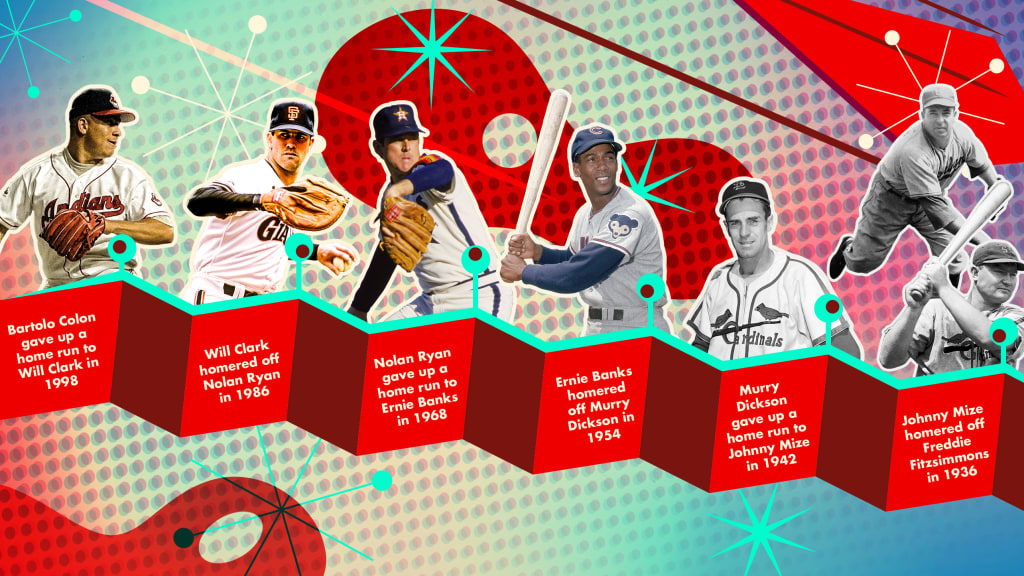
Obviously, we have no choice but to go with Colon (and no, we’re not going to follow his home run path … though we could).
On May 7, 1998, Colon -- in his breakout season with the Indians -- gave up a two-run home run to Will Clark that prevented the pitcher from collecting his second shutout of the season.
Clark then homered off Nolan Ryan for his first big league homer on April 8, 1986 -- in the first inning of his first big league game, too. Not a bad way to start a career.
(Not surprising, Clark remembers the moment well.)
Ryan connected us to Ernie Banks on Sept. 10, 1968. Banks was the back-end of back-to-back homers off Ryan in the bottom of the seventh when Ryan entered in relief for the Mets in an eventual 8-1 loss.
Banks took us back to Murry Dickson in 1954. Banks’ home run came in the bottom of the ninth to tie the Phillies at 3 and allow the Cubs to beat Dickson, 4-3, in 12 innings.
You may not know much of Dickson these days, but this was a pitcher who threw more pitches than Joe Garagiola could physically call for, led the league in losses three straight years while pitching on some particularly poor Pirates teams, and also won 20 games for the 1951 Pirates -- a team that won only 64 times. Because the Cubs were two games worse, Dickson sadly doesn’t make the cut as the eighth member of the 20-game winner on a last-place team list.
Dickson is tied to Big Cat Johnny Mize, who crushed Dickson to the tune of five home runs and a 1.135 OPS in 46 career PA. His first, though, came back on July 11, 1942, and it was, best of all, of the inside the park variety.
Finally, Mize takes us to our last stop on this train, with his home run off Freddie Fitzsimmons on July 23, 1936.
Not too shabby considering we started with a player looking to make a comeback to the Majors.
Next up: The Rickey Henderson Way.
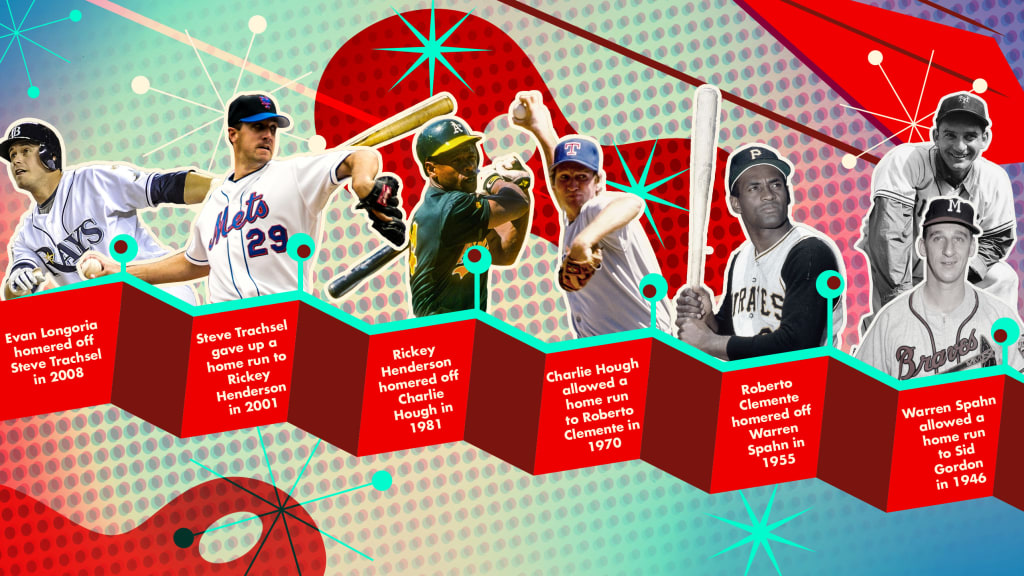
Since Henderson was the greatest ever to do it -- and he played in the Majors for roughly half the time baseball has existed (give or take a few years) -- we had to make one with Rickey. We also introduced another wrinkle: Henderson not only had to homer off the pitcher, but he also had to have stolen off him. Perhaps not shocking, this was fairly easy.
Starting with the most modern player, Evan Longoria had a two-homer game against Steve Trachsel on May 24, 2008. Trachsel then faced Henderson on May 17, 2001, who immediately got to work. Henderson drew a lead-off walk then stole second. His next time up, he went deep.
We then travel back to the glorious ‘80s as Henderson homered off knuckleballer Charlie Hough on Sept. 8, 1981. Though he didn’t swipe a bag on this day, he swiped second and third in quick succession off the knuckler on July 2, 1982.
We then traveled to Aug. 23, 1970 when Roberto Clemente went deep off Hough in an absolute laugher, with the Pirates winning 11-0.
Clemente is connected to Warren Spahn on May 3, 1955. Then in his rookie season, Clemente not only led off the game with a dinger in the Pirates’ 4-0 win, but this was also his first “real” home run. Two weeks before, he had hit an inside-the-park home run off the New York Giants’ Don Liddle, but this was his first that cleared the fence.
Finally, Spahn took us to Sid Gordon in 1946.
Once again, Gordon doesn't seem like such a big name, but it's where our experiment reveals some fun facts from baseball's past. From 1948-52, Gordon averaged 27 home runs a year for the Giants, with a .908 OPS and 146 OPS+ -- essentially Freddie Freeman's batting line for the past five years.
He was even considered the Freddie Freeman of his time, too. He was called a “solid man,” was cheered for inside his rival's home of Ebbets Field and, when he was traded from the Giants, the owner sent him a check for $2,500 just because.
Let's try another one. Let's head over to Greg Maddux's Professor's Laboratory.
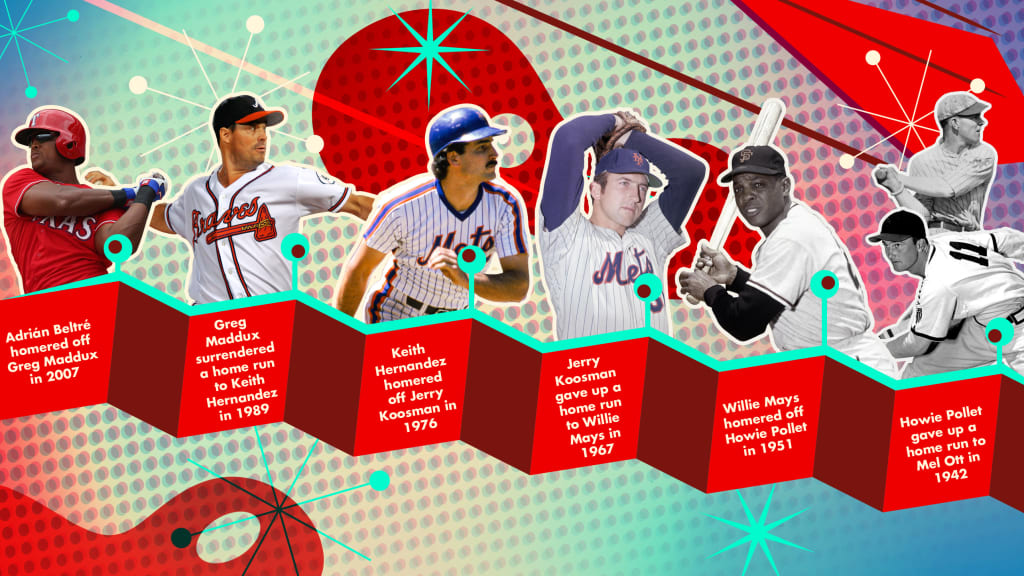
We’ll begin when Adrián Beltré homered off Greg Maddux on May 30, 1999.
What makes this one such fun is this dinger was hit one inning after Maddux went deep himself:
Maddux then gave up a home run to the mustachioed Keith Hernandez on April 22, 1989. It was a game noted for its blustery winds and freezing temperatures. So, you know, classic Wrigley. Hernandez’s home run looked to be a simple fly ball, but “the hometown breeze plunked the ball into the Cubs bullpen,” Alan Solomon wrote in The Chicago Tribune.
Hernandez then homered off another Mets legend, Jerry Koosman, on Sept. 16, 1976. It was the only run Koosman gave up that day in a complete game victory -- his 20th of the year -- over the Cardinals.
Koosman then takes us back to a future Met -- giving up a dinger to Willie Mays on Sept. 26, 1967. Mays would later hit a second off Bill Connors in the 7th inning. Shockingly, this was a season where some began wondering if Mays would be better off becoming a player-manager, as he struggled with a variety of injuries and a bout with the flu.
Instead, Mays would play for six more seasons -- topping a 120 OPS+ in everything but his final season in New York.
Mays then homered off Howie Pollet on June 17, 1951. And finally, Pollet got us to Mel Ott on May 19, 1942. It was the second homer of the inning for the Giants, and one batter later, when Pollet hit Johnny Mize, he was lifted from the game.
We don't have to just go as far back in history as possible. We can also do it to make one fan base very happy, or conversely, another extremely unhappy.
Like, a series of Red Sox players homering off Yankees hurlers.
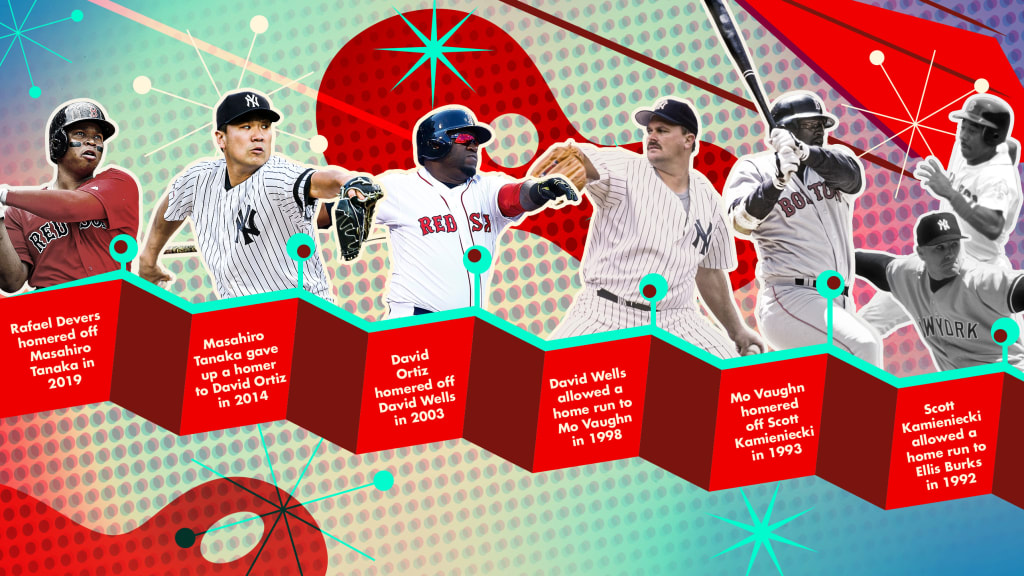
Sure, maybe some of the most significant moments in the rivalry are missing, and we only made it as far back as when "Cheers" was still on the air, but this path does feature some of the biggest Red Sox sluggers -- from the burgeoning superstar that is Rafael Devers back to Mo Vaughn and the great What If of Ellis Burks.
While Devers' dinger came in an easy Red Sox win, David Ortiz's home run against Tanaka on April 22, 2014 was just a small blip in the Yankees' 9-3 victory.
Ortiz also homered off David Wells on Independence Day -- July 4, 2003 -- when the burly southpaw was in his second tour wearing Yankees pinstripes. It was not a great day for Wells, as Ortiz's blast was one of five home runs that he gave up in 5 2/3 IP.
Wells -- then in his first time with the Yankees -- gave up a home run to Mo Vaughn on May 23, 1998. Wells had gone three hitless innings before Vaughn's home run, which was a big deal considering this was his first start since throwing his perfect game in his previous start.
Vaughn then homered off Scott Kamieniecki on Aug. 10, 1993 in the Red Sox's 5-0 win over the Yankees -- a big deal at the time as the two were chasing the Blue Jays for the division title.
Finally, we go back to Kamieniecki's two-run shot he gave up to Ellis Burks on June 17, 1992 -- Burks' second consecutive game coming up big against his Yankee rivals.
Of course, to wrap up, we have no choice but to give you what we teased at the outset: Mike Trout to Old Hoss Radbourn. We had to break our rule of only using six players, but this is the kind of connection for lovers, dreamers and me.
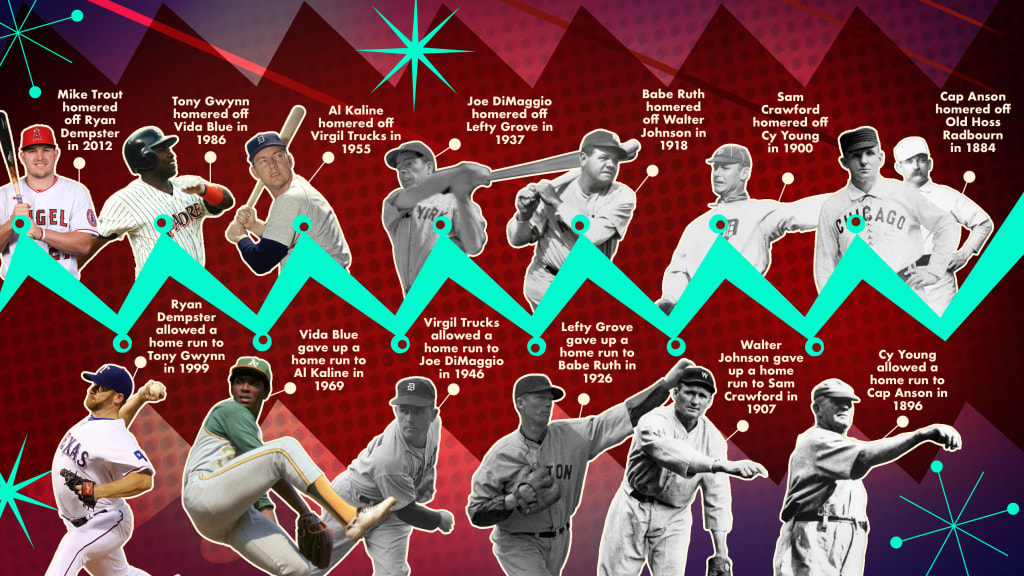
This list features 10 Hall of Famers (11 if you consider Trout to be a near-certain lock), 26 World Series titles (27 if you consider Old Hoss Radbourn's 1884 championship a World Series title), 11 MVP Awards, and every other honor conceivable.
There are too many big names and moments to run through everyone, but we'll note the highlights:
- Tony Gwynn's home run off Ryan Dempster on Aug. 14, 1999 was his first homer in a two-homer game. The Hall of Famer only accomplished that four times in his career.
- Joe DiMaggio's home run off Virgil Trucks on May 23, 1946 broke a 5-5 tie, and it was part of eight consecutive Yankees hits as they chased two pitchers (including Trucks) who failed to record an out in New York's 12-6 win. DiMaggio's home run was also the first of three straight Yankees homers which tied a then-record.
- DiMaggio then took us to Lefty Grove, who he homered off in an epic 8-5, 14-inning victory that was the first game of a doubleheader. The Boston Globe's headline read: "Close decisions, near fist fights, players put out of the game, thrill huge crowd at Fenway." There was even this amazing cartoon if you want a full recap of the day:
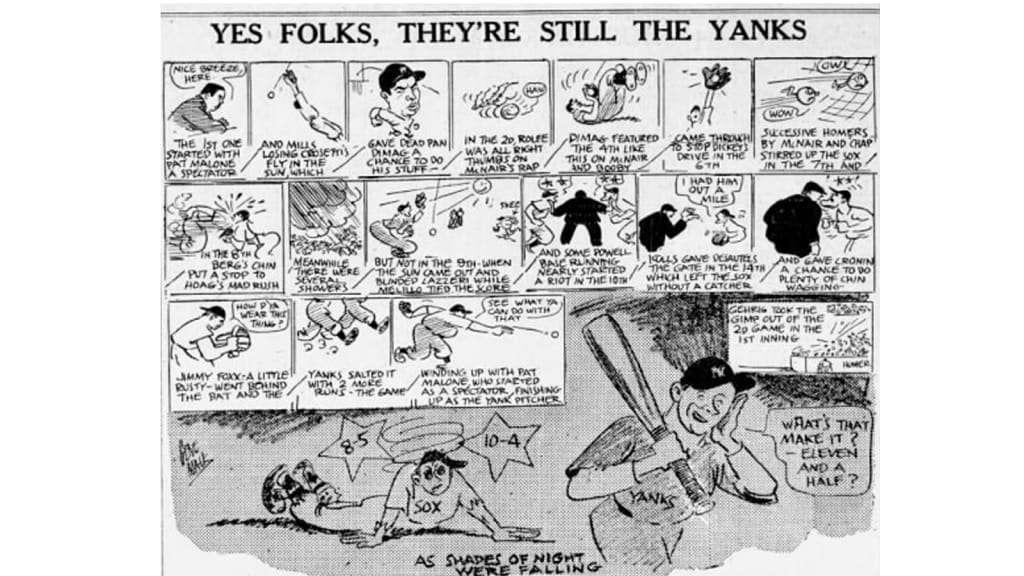
- Babe Ruth -- then still a Red Sox -- hit the game-winning two-run home run in the 10th inning on June 30, 1918 to give Boston a 3-1 victory over Walter Johnson's Senators.
- Sam Crawford hit the only home run in Detroit's 3-2 victory over Johnson on Aug. 2, 1907. (Sadly, there is no play-by-play data for this game, so Detroit's run in the ninth inning may have been Crawford, or it could have been scored by someone else.
Sadly, while we know who hit the home runs -- bringing us all the way back to Cap Anson's home run off Radbourn in his White Stockings' 8-6 loss to Radbourn's Providence Grays -- the box scores just don't exist, depriving us of the ability to know just how crushing or futile the dingers truly were.
Still, it's pretty impressive to think that we traveled nearly 150 years into baseball's past, collecting a full menagerie of Hall of Famers along the way, and it all started (or ended, depending on how you read it) with Trout's longball in 2012.
